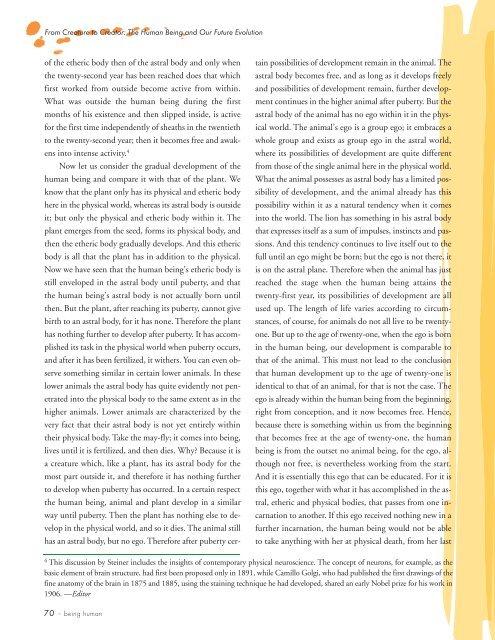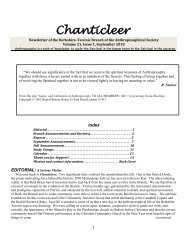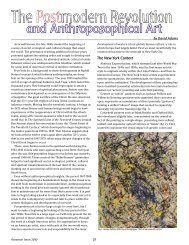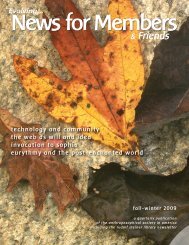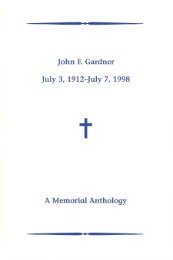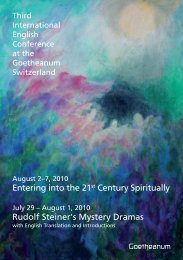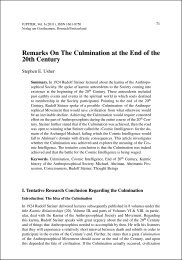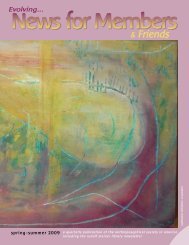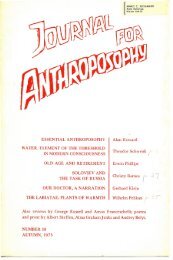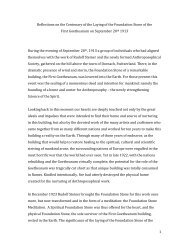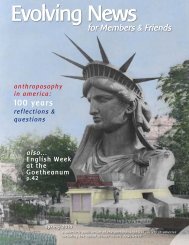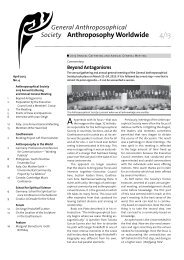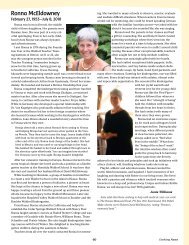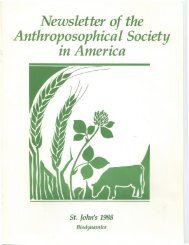Rudolf Steiner's Vision for the Future - Anthroposophical Society in ...
Rudolf Steiner's Vision for the Future - Anthroposophical Society in ...
Rudolf Steiner's Vision for the Future - Anthroposophical Society in ...
Create successful ePaper yourself
Turn your PDF publications into a flip-book with our unique Google optimized e-Paper software.
From Creature to Creator: The Human Be<strong>in</strong>g and Our <strong>Future</strong> Evolution<br />
of <strong>the</strong> e<strong>the</strong>ric body <strong>the</strong>n of <strong>the</strong> astral body and only when<br />
<strong>the</strong> twenty-second year has been reached does that which<br />
first worked from outside become active from with<strong>in</strong>.<br />
What was outside <strong>the</strong> human be<strong>in</strong>g dur<strong>in</strong>g <strong>the</strong> first<br />
months of his existence and <strong>the</strong>n slipped <strong>in</strong>side, is active<br />
<strong>for</strong> <strong>the</strong> first time <strong>in</strong>dependently of sheaths <strong>in</strong> <strong>the</strong> twentieth<br />
to <strong>the</strong> twenty-second year; <strong>the</strong>n it becomes free and awakens<br />
<strong>in</strong>to <strong>in</strong>tense activity. 4<br />
Now let us consider <strong>the</strong> gradual development of <strong>the</strong><br />
human be<strong>in</strong>g and compare it with that of <strong>the</strong> plant. We<br />
know that <strong>the</strong> plant only has its physical and e<strong>the</strong>ric body<br />
here <strong>in</strong> <strong>the</strong> physical world, whereas its astral body is outside<br />
it; but only <strong>the</strong> physical and e<strong>the</strong>ric body with<strong>in</strong> it. The<br />
plant emerges from <strong>the</strong> seed, <strong>for</strong>ms its physical body, and<br />
<strong>the</strong>n <strong>the</strong> e<strong>the</strong>ric body gradually develops. And this e<strong>the</strong>ric<br />
body is all that <strong>the</strong> plant has <strong>in</strong> addition to <strong>the</strong> physical.<br />
Now we have seen that <strong>the</strong> human be<strong>in</strong>g’s e<strong>the</strong>ric body is<br />
still enveloped <strong>in</strong> <strong>the</strong> astral body until puberty, and that<br />
<strong>the</strong> human be<strong>in</strong>g’s astral body is not actually born until<br />
<strong>the</strong>n. But <strong>the</strong> plant, after reach<strong>in</strong>g its puberty, cannot give<br />
birth to an astral body, <strong>for</strong> it has none. There<strong>for</strong>e <strong>the</strong> plant<br />
has noth<strong>in</strong>g fur<strong>the</strong>r to develop after puberty. It has accomplished<br />
its task <strong>in</strong> <strong>the</strong> physical world when puberty occurs,<br />
and after it has been fertilized, it wi<strong>the</strong>rs. You can even observe<br />
someth<strong>in</strong>g similar <strong>in</strong> certa<strong>in</strong> lower animals. In <strong>the</strong>se<br />
lower animals <strong>the</strong> astral body has quite evidently not penetrated<br />
<strong>in</strong>to <strong>the</strong> physical body to <strong>the</strong> same extent as <strong>in</strong> <strong>the</strong><br />
higher animals. Lower animals are characterized by <strong>the</strong><br />
very fact that <strong>the</strong>ir astral body is not yet entirely with<strong>in</strong><br />
<strong>the</strong>ir physical body. Take <strong>the</strong> may-fly; it comes <strong>in</strong>to be<strong>in</strong>g,<br />
lives until it is fertilized, and <strong>the</strong>n dies. Why? Because it is<br />
a creature which, like a plant, has its astral body <strong>for</strong> <strong>the</strong><br />
most part outside it, and <strong>the</strong>re<strong>for</strong>e it has noth<strong>in</strong>g fur<strong>the</strong>r<br />
to develop when puberty has occurred. In a certa<strong>in</strong> respect<br />
<strong>the</strong> human be<strong>in</strong>g, animal and plant develop <strong>in</strong> a similar<br />
way until puberty. Then <strong>the</strong> plant has noth<strong>in</strong>g else to develop<br />
<strong>in</strong> <strong>the</strong> physical world, and so it dies. The animal still<br />
has an astral body, but no ego. There<strong>for</strong>e after puberty cer-<br />
70 • be<strong>in</strong>g human<br />
ta<strong>in</strong> possibilities of development rema<strong>in</strong> <strong>in</strong> <strong>the</strong> animal. The<br />
astral body becomes free, and as long as it develops freely<br />
and possibilities of development rema<strong>in</strong>, fur<strong>the</strong>r development<br />
cont<strong>in</strong>ues <strong>in</strong> <strong>the</strong> higher animal after puberty. But <strong>the</strong><br />
astral body of <strong>the</strong> animal has no ego with<strong>in</strong> it <strong>in</strong> <strong>the</strong> physical<br />
world. The animal’s ego is a group ego; it embraces a<br />
whole group and exists as group ego <strong>in</strong> <strong>the</strong> astral world,<br />
where its possibilities of development are quite different<br />
from those of <strong>the</strong> s<strong>in</strong>gle animal here <strong>in</strong> <strong>the</strong> physical world.<br />
What <strong>the</strong> animal possesses as astral body has a limited possibility<br />
of development, and <strong>the</strong> animal already has this<br />
possibility with<strong>in</strong> it as a natural tendency when it comes<br />
<strong>in</strong>to <strong>the</strong> world. The lion has someth<strong>in</strong>g <strong>in</strong> his astral body<br />
that expresses itself as a sum of impulses, <strong>in</strong>st<strong>in</strong>cts and passions.<br />
And this tendency cont<strong>in</strong>ues to live itself out to <strong>the</strong><br />
full until an ego might be born; but <strong>the</strong> ego is not <strong>the</strong>re, it<br />
is on <strong>the</strong> astral plane. There<strong>for</strong>e when <strong>the</strong> animal has just<br />
reached <strong>the</strong> stage when <strong>the</strong> human be<strong>in</strong>g atta<strong>in</strong>s <strong>the</strong><br />
twenty-first year, its possibilities of development are all<br />
used up. The length of life varies accord<strong>in</strong>g to circumstances,<br />
of course, <strong>for</strong> animals do not all live to be twentyone.<br />
But up to <strong>the</strong> age of twenty-one, when <strong>the</strong> ego is born<br />
<strong>in</strong> <strong>the</strong> human be<strong>in</strong>g, our development is comparable to<br />
that of <strong>the</strong> animal. This must not lead to <strong>the</strong> conclusion<br />
that human development up to <strong>the</strong> age of twenty-one is<br />
identical to that of an animal, <strong>for</strong> that is not <strong>the</strong> case. The<br />
ego is already with<strong>in</strong> <strong>the</strong> human be<strong>in</strong>g from <strong>the</strong> beg<strong>in</strong>n<strong>in</strong>g,<br />
right from conception, and it now becomes free. Hence,<br />
because <strong>the</strong>re is someth<strong>in</strong>g with<strong>in</strong> us from <strong>the</strong> beg<strong>in</strong>n<strong>in</strong>g<br />
that becomes free at <strong>the</strong> age of twenty-one, <strong>the</strong> human<br />
be<strong>in</strong>g is from <strong>the</strong> outset no animal be<strong>in</strong>g, <strong>for</strong> <strong>the</strong> ego, although<br />
not free, is never<strong>the</strong>less work<strong>in</strong>g from <strong>the</strong> start.<br />
And it is essentially this ego that can be educated. For it is<br />
this ego, toge<strong>the</strong>r with what it has accomplished <strong>in</strong> <strong>the</strong> astral,<br />
e<strong>the</strong>ric and physical bodies, that passes from one <strong>in</strong>carnation<br />
to ano<strong>the</strong>r. If this ego received noth<strong>in</strong>g new <strong>in</strong> a<br />
fur<strong>the</strong>r <strong>in</strong>carnation, <strong>the</strong> human be<strong>in</strong>g would not be able<br />
to take anyth<strong>in</strong>g with her at physical death, from her last<br />
4 This discussion by Ste<strong>in</strong>er <strong>in</strong>cludes <strong>the</strong> <strong>in</strong>sights of contemporary physical neuroscience. The concept of neurons, <strong>for</strong> example, as <strong>the</strong><br />
basic element of bra<strong>in</strong> structure, had first been proposed only <strong>in</strong> 1891, while Camillo Golgi, who had published <strong>the</strong> first draw<strong>in</strong>gs of <strong>the</strong><br />
f<strong>in</strong>e anatomy of <strong>the</strong> bra<strong>in</strong> <strong>in</strong> 1875 and 1885, us<strong>in</strong>g <strong>the</strong> sta<strong>in</strong><strong>in</strong>g technique he had developed, shared an early Nobel prize <strong>for</strong> his work <strong>in</strong><br />
1906. —Editor


